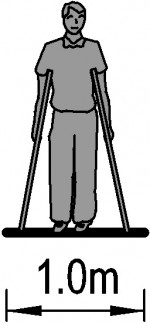Physical space is relevant to design of the widths of paths, crossings, and refuge areas for pedestrians. The space that pedestrians need depends on the devices people use on paths. Walking speed is relevant to the design of crossings.
Pedestrians require different spaces within which to manoeuvre. Newer wheelchairs are increasingly variable in their dimensions and this should be considered in design. Mobility scooters are usually longer but the same width as manual wheelchairs. The following technical note outlines technical design requirements to accommodate mobility scooters on paths and at crossings and intersections.
Horizontal geometric design for mobility scooters (Waka Kotahi technical advice note #21-06)
The situation below shows the clear widths for manoeuvring various mobility devices, the widths referred are not minimum footpath widths. NZS 4121 outlines recommended widths for people using different devices (long canes, crutches, guide dogs) [1]

1 metre of physical space. |
A clear width of 1000mm is adequate for people with ambulant disabilities. It just allows passage for 80 percent of people who use wheelchairs. |

1.2 metres of physical space. |
People who use wheelchairs require a clear width of 1.2m. |

1.5 metres of physical space. |
A clear width of 1.5m allows a wheelchair and a pram to pass. |

1.8 metres of physical space. |
To allow two wheelchairs to pass comfortably, a clear width of 1.8m is required. |
Walking speed is affected by pedestrians’ capabilities and states.
PNG: Human capabilities and states
A range of speeds could be expected on footpaths because of other users on devices. The chart below illustrates the range of operating speeds for various active modes that could be present on paths.

Operating speed ranges for various active modes.
People walk at a range of speeds depending on pedestrian characteristics such as age, gender and physical condition, but also trip characteristics such as walking purpose, route familiarity, trip length and encumbrances.
Route characteristics such as width, gradient, surfacing, shelter, attractiveness, pedestrian density and crossing delays and also environmental characteristics such as weather conditions can impact walking speed.
In some contexts, for example traffic signal timings, it is important to design for people who walk more slowly to ensure they have time to cross safely. However, in other contexts, for example when identifying a walking catchment or in accessibility modelling it may be appropriate to apply a 50th percentile or average person’s walking speed. Recommended walking speeds applicable for different purposes are outlined below.
Crossing design including sight distance, pedestrian delay and traffic signal pedestrian clearance times:
Transport modelling, walking catchments – 4.8km/h to 5.0km/h (ie 1.3 to 1.4m/s)[2]
The Land Transport (Road User) Rule 2014 currently allows a person using a wheeled recreational device to use either the footpath or the roadway.
Land Transport (Road User) Rule 2014
For design purposes, it may be assumed that skateboarders, kick scooter users, roller skaters, in-line skaters and runners/joggers are walking pedestrians and, therefore, subject to the same design principles as those travelling on foot. High quality walking routes including safe road crossings and smooth kerb transitions benefit users of small wheeled devices as well as people with temporary or permanent impairments.
[1] Standards New Zealand. (2001). Design for access and mobility: Buildings and associated facilities(external link) NZS 4121:2001
[2] Akcelik & Associates. (2001). An investigation of pedestrian movement characteristics at Midblock signalised crossings